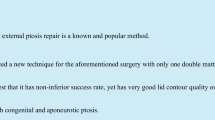Abstract
There is no single surgical procedure which has the ability to correct all types of ptosis. Different procedures are used depending on the severity of ptosis and levator function.
The single-stitch levator advancement technique is simple, effective, and versatile. It gives excellent results in patients with ptosis ranging from 1 to 5 mm as long as the ptotic lid has at least 8 mm of levator function. It is applicable in most of the involutional, traumatic, and postsurgical ptosis and some of the congenital ptosis.
This procedure may be performed with local injection only or with additional intravenous sedation. Over- and undercorrection are rare. This same procedure may be repeated without difficulty because the normal eyelid anatomy is not disturbed.
Access provided by Autonomous University of Puebla. Download chapter PDF
Similar content being viewed by others
Keywords
This versatile, simple, and effective technique for ptosis repair can be used to correct most cases of involutional, traumatic, and postsurgical ptosis of 1–5 mm. The ptotic lid must have at least 8 mm of levator function (Liu 1993). The procedure may be performed with local injection only or with additional intravenous sedation. The essential steps for performing this procedure are as follows:
-
1.
Identify, mark, and inject the lid crease with no more than 0.5 ml of 2 % lidocaine with epinephrine. A larger amount of injection tends to distort the lid anatomy and affect the function of various extraocular muscles, affecting the surgical result. Allow 10 min for hemostasis.
-
2.
Use a No. 15 blade to make the skin incision and a curved Stevens scissors and 0.5 forceps to perform layered dissection. Undermine the orbicularis superiorly for about 10 mm.
-
3.
Identify the orbital septum by grasping and tugging the tissue in question with a forceps and placing a finger at the superior orbital rim. The orbital septum is identified when your finger feels the tug at the superior orbital rim. This helps identify the different layers and structures throughout the procedure.
-
4.
Open the orbital septum with the scissors 5 mm above the skin incision to avoid injuring the levator aponeurosis (Fig. 189.1). If this incision is too low, the aponeurosis and conjunctiva could be inadvertently incised. Prolapse of preaponeurotic fat into view serves as an indication that the incision is indeed of orbital septum. In patients with little fat, the levator aponeurosis comes directly into view once the orbital septum is opened.
-
5.
Place a curved Stevens scissors flat on the fat pad following the curvature of the globe with blades closed. Snip the fat capsule open at the most inferior point. Go into the fat pad for a few millimeters and open the scissors. The glistening smooth levator aponeurosis is seen between the open blades just beneath the fat (Fig. 189.2). Now apply a Desmarres retractor superiorly to get the fat out of the way.
-
6.
To better expose the superior portion of the levator aponeurosis, the surgeon gently rolls a cotton-tipped applicator on the aponeurosis while asking the patient to look down at his toes. Roll the applicator gently, do not pull the levator aponeurosis with forceps. This maneuver is key to a successful repair.
-
7.
Place a 6-0 nylon suture in the central portion of the aponeurosis superiorly with a 2-mm bite (Fig. 189.3). This suture may be used as a traction suture if the initial placement is not high enough. Rarely a patient feels minor momentary discomfort.
-
8.
Anchor the same nylon suture in the anterior surface of the superior tarsus and place a temporary slipknot. This suture should be 1–2 mm medially displaced from the mid-pupillary line. Observe the lid curvature and height and make appropriate adjustment as necessary.
-
9.
As the knot is being tied, watch the lid move up and aim for a 1- to 2-mm overcorrection or with a 2-mm lagophthalmos upon gentle lid closure.
-
10.
When the lid height and curvature are satisfactory, tie the nylon suture permanently and cut its ends short. Double-check the lid curvature and height before skin closure. Close the skin with 6-0 nylon or other preferred suture.
-
11.
Instruct the patient to apply ice-cold compress over the operative eyelid for 3 days and to avoid any rubbing or squeezing of the lid.
-
12.
Over- or undercorrection rarely occurs with this technique. If overcorrection is seen early postoperatively, it can be managed by downward massage of the lid. Undercorrection and recurrence of ptosis may require a repeat operation. Since anatomy is minimally disturbed, a repeat operation is usually very simple.
-
13.
Peaking of the lid is seen rarely and tends to spontaneously resolve in a few days to weeks.
Reference
Liu D. Simplified ptosis repair: single suture aponeurotic tuck. Ophthalmology. 1993;100:251–9.
Author information
Authors and Affiliations
Corresponding author
Editor information
Editors and Affiliations
Rights and permissions
Copyright information
© 2015 Springer Science+Business Media New York
About this chapter
Cite this chapter
Liu, D. (2015). Ptosis Repair by a Single-Stitch Levator Advancement. In: Hartstein, MD, FACS, M., Massry, MD, FACS, G., Holds, MD, FACS, J. (eds) Pearls and Pitfalls in Cosmetic Oculoplastic Surgery. Springer, New York, NY. https://doi.org/10.1007/978-1-4939-1544-6_189
Download citation
DOI: https://doi.org/10.1007/978-1-4939-1544-6_189
Published:
Publisher Name: Springer, New York, NY
Print ISBN: 978-1-4939-1543-9
Online ISBN: 978-1-4939-1544-6
eBook Packages: MedicineMedicine (R0)






